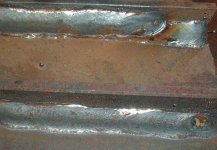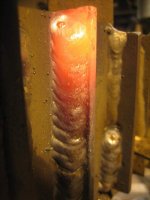Now where to start?
Comments were made comparing the capabilities of Stick vs. Mig and which is better at producing stronger welds.
Let us look at AC stick and what´s going on in the arc. AC is Alternating Current, here in the US Alternating Current changes direction every 1/60 of a second, that means the voltage and current is 0 three times each cycle and for a brief instant the arc is off. For that brief instant, inconsistencies in the weld bead can develop that you would not want in anything critical. On the plus side, the reversing current welds going in one direction and cleans in the other direction, making up for some of its shortcomings, X-ray testing would show some defects. Now is it a good weld, that all depends to what standard it must meet?
Hence DC, + and depending on the rods, gives a smoother arc, deeper penetration and many more choices of metal that may be joined.
Mig produces very clean weld beads. First used in WWII aircraft to fabricate aluminum and magnesium parts. Later when better shielding gas and solid wire for steel were developed and with the faster feed rate, Mig became the choice in industry. However, the Mig unites were expensive. Smaller units for fabrication shops with fewer bells and whistles came along but were still pricy. Economy models came along that were striped down to basics. Now there are limits to how much could be taken out and still have a Mig and that's where I think the trouble starts. The marketing people get involved and try to sell the sizzle and not the stake, they clam their $100 unit is just as good as that $5,000 Mig. Well look under the covers, ¼ in. copper bus bars are replaced with large gauge wire, rectifiers are cut back to bear minimums to just get by, cables are just adequate for the current, small or no cooling fans, capacitor banks that meet minimums. I smoked the rectifier assembly in my Mig; replacing it, I spent a few pennies on the new rectifier diodes coating the side of the diode that contacts the heat sink with Heat Sink Grease to efficiently conduct heat into the sink keeping the diodes cooler. I've also had my fingers in the unit to make up for other shortcomings.
So, when you compare Mig to Mig or a Stick do so on an equal footing, be it current or price.
Going back to the Miller book Gas Metal Arc Welding, there are photos of joints welded by Mig and Stick, cross-sectioned and etched showing the depth of penetration of each when welded under the same conditions, current and stock thickness. The Mig bead always has the deeper penetration, not my say-so, Millers say-so. The same comparative illustrations are done with shielding gas to show the effects of different gasses. CO2 is the least costly, penetrates deeply, however it produces lots of spatter, C-25 doesn't penetrate as deeply but has less spatter. There are tricks that can be done by changing the inductance in the circuit that improves the weld bead.
Another point that is missing form the discussions is the wire type-class. Most use ER70S-6. There is dash 2, 3,4,5,6, 7, G and so on. Each class is meant to have particular weld and strength profile, all have various amount of deoxidizers that affect the weld pool as your working. Let's take Silicon; it ranges from 0.8 to 1.15% by weight in the dash 6 wire. Silicon causes the weld bead to be brittle. ER70S-3 has 0.45 to 0.7 % silicon and is much more ductile than the dash 6; however, it is a sticky pool and doesn't flow well. The point I'm making is that not all the wire in a class is created equal. A manufacture can vary the ingreedance in the recipe, a bit more of this and bit less of that and still meet the classification. Now if you are having trouble with brand A, try the same class in brand B, another reason to conclude stick is better than Mig.
Here is a serecet, check to see if anyone is lessening, shhhhhh? Now keep this under your hat, the same goes for rods too, the recipe can vary from brand to brand.

